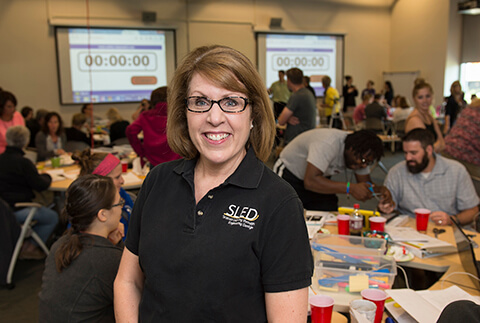Purdue Profiles: Brenda Capobianco
August 26, 2015
 |
|
Brenda Capobianco, associate professor of science education in the Department of Curriculum and Instruction with a courtesy appointment in the School of Engineering Education (Purdue University photo/John Underwood) |
For Brenda Capobianco, the opportunity to make her mark on the emerging field of STEM education research brought her to Purdue in 2002. Now, 13 years later, she's an associate professor of science education in the Department of Curriculum and Instruction with a courtesy appointment in the School of Engineering Education. She has published more than 30 articles and presented her research everywhere from Portland, Oregon, to Utrecht, Netherlands.
Capobianco, a former middle school science teacher herself, also spends her time as co-principal investigator of SLED, Science Learning through Engineering Design, an engineering design-based science education partnership with teachers of grades 3-6 in Indiana schools.
How did SLED begin?
It had its beginnings in 2007. I had started to study a fifth-grade classroom at Vinton Elementary School in Lafayette as part of my research. I would watch the kids perform a science activity -- making a better candy bag -- and I saw this "busy-happy-good" phenomenon. The kids were busy, the teacher was busy, she was happy, they were happy and it was all good. The kids were so excited, but they became overwhelmed with materials. It became one big craft project. So I said, "Why aren't they looking at the direction of force, measuring mass or calculating the volume of the bag?" I began to think about how we could change the task to make it more science-based, and that was where the idea began. SLED was then proposed to the National Science Foundation in 2009 and awarded in 2010.
What is the core of what SLED does?
The aim of the SLED partnership is to do just that: build and sustain a long-term partnership with K-12 schools in Indiana. Through this partnership, we hope to improve students' learning of science through engineering design. So, our primary goal was to build the partnership and then to introduce teachers to the engineering design process and show them how students can engage in the process to learn science and mathematics.
What is the big-picture goal of SLED?
Our objective was to have over 200 teachers and 3,000 students participate in the partnership. We have met that goal. We also wanted to create a bank of high-quality, engineering design-based tasks that were developed, pilot-tested, assessed and implemented by teachers. We succeeded in doing that as well. The long-term goal is to get students more interested in science and engineering so they can potentially become members of the workforce in STEM.
What is the future of SLED?
We plan to sustain the SLED partnership by empowering teachers to serve as teacher-leaders. During this summer's institute, we trained master SLED teachers to design professional development plans based on teacher interaction across schools and districts. We also have our SLED Hub that serves as an electronic depository for all of our curricular resources and videos. Lastly, we are pursuing additional funding not only to support the SLED teacher-leaders, but also to help university faculty translate the SLED model into undergraduate STEM education courses.
Do you have a personal favorite project that the students do?
My favorite would have to be one that we created this summer based on my experience while visiting my two nieces. They have a Great Dane, and I noticed it's really hard to get that dog in and out of the car. I asked the girls how they would use simple machines to create a device to move the dog. With help from a colleague in Purdue's College of Veterinary Medicine, we created a design brief and implemented it in the first week of our Summer Institute. The teachers showed their prototypes to my niece's classroom, and the students scored the prototypes. It put the teachers in the position of being a student and having their work critiqued, as well as positioning them to think how their students would experience the task.
I like this one is because of the ethic of care that young children have -- they want to help. And oftentimes when they talk about who they want to become when they grow up, it's police officers, teachers and vets -- caring professions. They rarely mention engineers. So we asked ourselves how to make engineering a caring profession, so that children say, "Hey, I can see myself doing this!" And I think we succeeded with this project.

